 |
| Butterflies, leaves and birds, flowers, a snake, broken ceramic tile, and glass drops. |
I often get inquiries on the actual making of the mosaic inserts. Here is an excerpt from a lovely email I received a few days ago, and my reply:
Hello, Marylou!
You don't know me, but I've been browsing your Earthmaid blog website and dreaming about your wonderful work! I especially love your mosaic inserts! I've seen many mosaic projects, and liked them, but your mosaic insert designs are what most captured my attention. After browsing your website, I went on a hunt to find inserts like yours -- I thought I would begin collecting tiles for a future project. However, I soon discovered that your tiles are one-of-a-kind! I couldn't find anything like them anywhere—either locally or even online. As a teacher, I recently relocated to a middle school. I'm excited because now I can explore many more art techniques and media with my older students.
Your work has inspired me to learn more about working with clay. I have done many different art forms, including some basic mosaic designs with stained glass, but haven't done ceramic work—yet! On your blog, you describe how to do mosaics, which is wonderful! However, I am most interested in learning more about how you create the tiles themselves—the techniques you use to create the designs on the tiles. I'd love to try making some inserts for my personal use for mosaics—and I'm also imagining that they'd make wonderful pendants, too. I suppose that using polymer clay for pendants would work, but I would like to explore working with clay -- I wonder if my students could try the technique you use to make small projects, or if it would be too difficult. Would you be willing to tell me more about how you make your inserts, and the techniques you use, or point me in the right direction to find information via the internet or an excellent book resource? I am interested in purchasing some of your inserts, but I can well imagine that if I wanted to get enough for a mosaic project like the mosaic table you feature on your blog site, it would cost me a small fortune to get them to Canada! If you do sell them, I'd like information on how I could order them and the cost to purchase and ship them to Canada. Thank you so much for sharing your work through your blog, and I hope to hear from you soon!
I replied:
Thanks for the email and kind words.
If your school has its own kiln and pottery equipment, then making your own inserts will be a fun thing to do.
I would suggest you start by getting a slab of clay rolled out—about 6 mm thick, either on a slab roller or by using a rolling pin and 2 dowels. Get a book from the library on handmade tiles to see how to make a slab.
Then when it has firmed a bit, press cookie cutters into the clay. Or press leaves, veins down, into the clay. Cut with a sharp-tipped knife around the leaves. Or use a paper template and a knife to cut out animal shapes, hearts, or whatever. Remove the in-between bits, leaving the shapes on a wooden board (or bat, as they are called in pottery studios) to dry overnight.
The next day they should be firm enough for you to pick up and clean off the edges.
Then when they are dry, decorate and fire in a kiln.
I paint on the underglaze and then scratch through it to make designs—sgraffito.
I use plaster of Paris to make molds of the inserts I make, and that is another long process—but if I were teaching a class to kids, I would use the slab method.
Regards and hope you have fun.
There are many good "how to make tiles" books at the local library. Tutorials with step by step pictures will be helpful.
Tips for Working with Clay Leaf Shapes
-
Eliminate Air Bubbles
When rolling out your clay slab, take care to remove any air bubbles. These can cause cracks or even small explosions during firing. Wedge or knead the clay thoroughly before rolling it out to ensure a smooth, even texture.
-
Handle with Care
Avoid touching or moving the shapes while the clay is still soft and floppy. At this stage, it’s very fragile and can easily stretch or distort. Wait until it has firmed up slightly — to the “leather-hard” stage — before doing any trimming or refining.
-
Keep the Shapes Flat
To help your clay pieces dry evenly and stay flat, place a sheet of newspaper over them, then gently set a flat board on top. Add a light weight if needed. This prevents warping and keeps your shapes perfectly smooth as they dry.
-
Refine the Edges
Once the clay has reached the leather-hard or dry stage, use a damp sponge to smooth and soften the edges. This small step gives your finished pieces a more professional, polished look.
-
Control the Drying Speed
Clay that dries too quickly can crack — especially in warmer weather. To slow the process, cover unfinished projects with clear plastic. A clever tip: an old fridge (unplugged, of course!) makes an excellent storage space for clay work in progress, helping maintain consistent moisture levels.
Let Your Creativity Shine: Making Ceramic Mosaic Pieces
One of the best things about working with clay is how much fun you can have experimenting! Beginners and kids will enjoy simple decoration techniques like wax resist, sgraffito, or one-color designs. Sometimes, keeping it simple creates the most striking results — a little goes a long way!
Don’t forget about rubber stamps! Press them into your clay slabs when the clay is just the right firmness — not too soft, not too dry — and watch the textures come alive. Let imaginations run wild, but remember: supervise carefully, as some cutting tools are sharp. And save those little leftover clay bits for recycling — nothing goes to waste!
Once your leaf impressions and shapes are dry, decorating with underglazes is easy and magical. Apply the color, let it dry, and gently wipe off the surface — the pigment stays nestled in the impressions, highlighting every detail. Then comes the fun part: bisque firing at 1000°C, followed by a glaze firing. Choose translucent glaze for a glossy finish, or leave it unglazed for a lovely, natural matte look.
Pottery is full of surprises — even if you’ve been working with clay for years, there’s always something new to discover about textures, glazes, firing, and decoration. This blog focuses on mosaics, but I hope it inspires you to create your own beautiful, one-of-a-kind mosaic inserts.
P.S. If this post sparks your creativity, please share my EarthMaid blog with friends and family. Every view and comment helps — one day I hope to bring even more exciting projects to you with sponsorship support. Most of all, have fun, get messy, and let your creativity shine!



















































